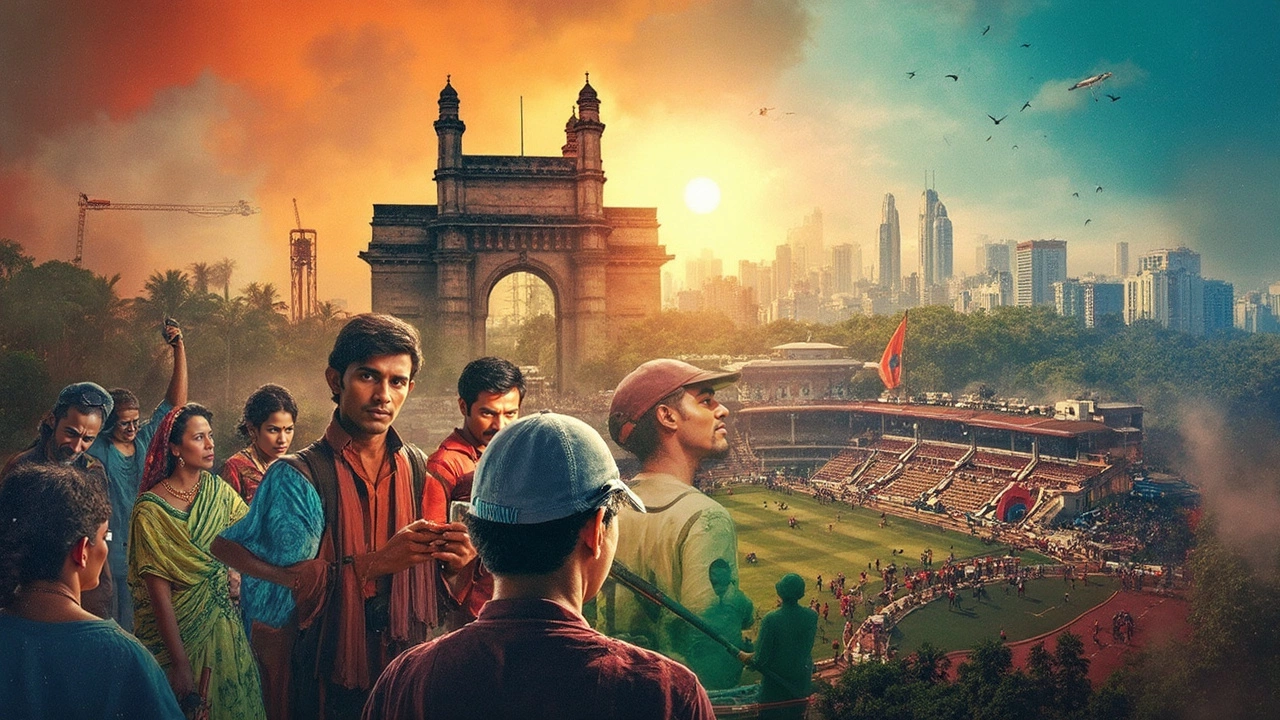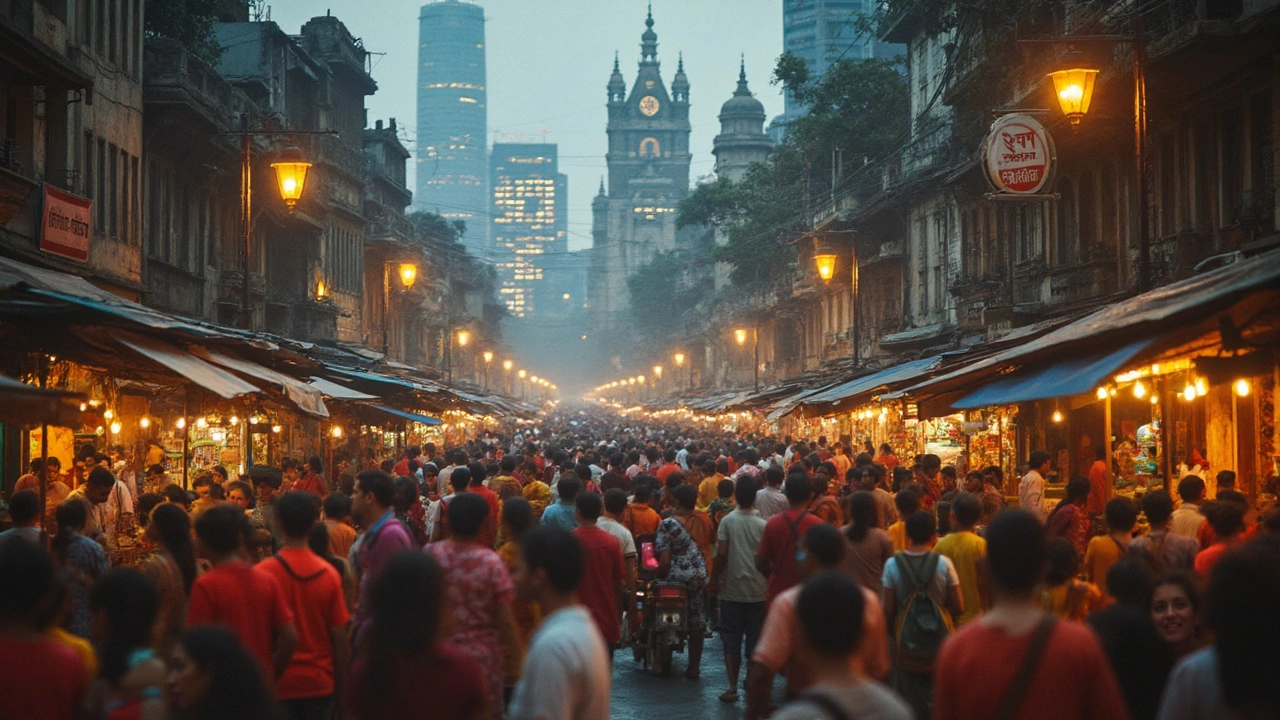40,000 fortune seekers. That’s the average number of new people who arrive every single day in Mumbai, each of them hoping to make it big. Some come for Bollywood glory, others for tech careers or fashion fame. For centuries, this city has somehow made room for all their ambitions, turning hopes into homes and ideas into actual lives. No other city in India is wired this way—where ‘dreams’ aren’t just metaphors but daily fuel for survival and reinvention. If anywhere in India truly runs on the power of dreams, it’s Mumbai, where possibility is crammed into every street corner, and the word ‘impossible’ doesn’t fly.
How Mumbai Earned Its ‘City of Dreams’ Tag
Mumbai wasn’t always this restless, sprawling magnet. Once, it was a scattered set of fishing islands called Bombay. When the British took over in the 17th century, they built docks and railway lines, and immigrants came running from Gujarat, Bengal, Tamil Nadu, and way beyond. It didn’t matter to them that the city’s buildings looked like they were glued together with hope and humidity—the vibe was, and still is, relentless hustle. After the Partition in 1947, Mumbai grew even more chaotic and multicultural, absorbing wave after wave of people looking to rebuild broken lives. The term ‘city of dreams’ may sound cheesy, but the city made sure those arriving with nothing at all could sometimes become millionaires—or at least find a warm meal.
Bollywood is the most obvious symbol of Mumbai’s power to turn fantasies into reality. Every aspiring actor in India knows about Andheri West, the suburb lined with casting studios and chai stalls where hopefuls wait in endless queues for their big break. The Hindi film industry here churns out around 1,500 films a year, many shot on those picturesque streets where vendors sell vada pav for less than a dollar. Billboards showcase the latest megastars, but just a rickshaw ride away, strugglers fight for tiny roles, all clutching the same dream. In no other Indian city does folklore and reality intertwine so dramatically.
No one pretends Mumbai is easy, though. The city is famous for its monsoons that flood the streets, the heart-stopping local trains, and insane rents. Yet, when you ask locals why they stay, the answer is always the same: "Because here, anything can happen." It’s not just Bollywood, either. The finance sector, tech start-ups, and relentless street entrepreneurs make Mumbai the richest city in India, pumping out more millionaires than anywhere else. Some succeed, sure, but Mumbai also has thousands living in slums next to luxury towers—a constant reminder of just how wild and unfair chasing dreams can be.
| Aspect | Mumbai | Other Major Indian Cities |
|---|---|---|
| Population | ~24 million | Delhi: ~16 million, Bangalore: ~12 million |
| Films Produced Annually | 1,500+ | Chennai: 250, Kolkata: 100 |
| Average Daily Arrivals | 40,000 | Delhi: 24,000, Bangalore: 12,000 |
| Average Apartment Rent (city center) | $800/mo | Delhi: $500/mo, Kolkata: $300/mo |
| Languages Spoken | More than 16 | Varies (usually less than 10) |
Living the Dream: Daily Grind and Glamour
Think Mumbai, and you picture throngs in local trains, all cramming into what should fit half their number, yet determined to get ahead. That’s the Mumbai spirit: dogged, inventive, and hungry. Street food is everywhere, fueling traders, techies, and film extras alike. Dabbawalas, famous for delivering thousands of home-cooked lunches daily without high-tech help, are legends here—global management schools even use them as case studies on organization and efficiency. Jugaad, that uniquely Indian knack for creative problem-solving, is practically a religion in Mumbai. If there’s a way to make something work, Mumbaikars will find it, even if it involves turning a broken bucket into a cellphone charger stand on Marine Drive.
Mumbai’s skyline tells its own story. Old Art Deco buildings shoulder up against glassy skyscrapers. Rooftops host pigeon coops and drone flights, sometimes on the same day. Every festival gets its party: Ganesh Chaturthi turns the city roads into pulsing rivers of color and music. Late October sees the city glowing with Diwali lights, and at Holi, even white-shirted bankers come home splattered in psychedelic dye. The most fun part? Anyone—truly anyone—can join the party, no invitation needed.
But it’s not all shimmering fantasy. Over 55% of Mumbai’s population still lives in informal settlements like Dharavi. Yet, even here, dreams blend with hard reality: Dharavi isn’t just one of Asia’s largest slums—its hundreds of tiny factories produce goods worth an estimated $1 billion each year. So many Mumbai millionaires, from the Ambanis to Bollywood directors, grew up just streets away from these neighborhoods. The city never completely erases the gap between luxury and hardship, but it lets them exist side by side, making ‘dreams’ here not just possible—but necessary.
If you’re hoping to chase your own Mumbai dream, here’s what helps: resilience, curiosity, and the ability to take a joke—especially about life’s ups and downs. Locals swear by networking as the real superpower, and chai shops are basically career accelerators. Want to meet a film director? Try an evening in Bandra. Looking for start-up co-founders? Powai’s cafés are packed with students and coders plotting the next breakthrough app.

Bollywood: Dreams, Disappointments, and Global Stardom
No other city in the world produces as many films in a year as Mumbai. Bollywood is the fantasy factory that churns out wild hope, heartbreaks, and overnight stars. Every year, thousands move here, hoping for a one-in-a-million shot at stardom. And sometimes, the city delivers—think of Shah Rukh Khan, who arrived from Delhi with nothing but theater experience and a suitcase; today, his face is recognized from New Zealand to Nigeria.
For every huge success, though, there are thousands who go home with lighter wallets but wilder stories. Most struggle for years, living eight to a room in chawls (cramped communal apartments), running between auditions that put them up against hundreds just like themselves. It’s dog-eat-dog, but the sheer volume of films, web series, and TV shows means that fresh faces do break in every single year. Mumbai rewards ambition but demands patience and thick skin.
It’s not just actors. Directors, costume designers, screenwriters, composers, stunt doubles—every creative job under the sun has a toehold in Mumbai. Film City in Goregaon is a 500-acre maze of studios where everything from rainstorms to medieval palaces can be constructed overnight. The best way to experience this? Tag along with a friend auditioning for an ad film—you’ll get a behind-the-scenes look that even tour buses miss. The energy bubbling around these spaces is contagious. No matter how many knock-backs you get, you’re always just an introduction or lucky break away from your next big gig. Mumbai is addictive that way.
Sometimes, the line between real and reel blurs. Mumbai’s police force, for example, is often more recognizable by its Bollywood portrayals than its real uniforms. Whole neighborhoods get painted for major shoots, and street kids get temporary jobs as extras, earning enough for their next week’s rent. More than once, regular commuters have found themselves catapulted into stardom via street-casting for a big Bollywood movie. Yes, it really happens.
Beyond The Movies: Other Industries Fueling Mumbai’s Dreams
It’s not just film—the financial and tech industries put Mumbai on the map too. Home to India’s main stock exchange, Mumbai runs the country’s economic engine. More than half of Fortune India 500 companies are headquartered here. If you want work that can take you from a cubicle to a luxury apartment, this is your place. The city’s IT sector has exploded in the last decade, with thousands of startups mushrooming in hubs like Andheri, Powai, and Lower Parel.
Fashion is massive in Mumbai, and Lakmé Fashion Week puts local talent on the international stage. Aspiring designers, models, and photographers crowd the city’s colorful bazaars and slick studios hoping to catch the eye of industry insiders. The music scene is equally alive; from superstar music directors to local rappers like DIVINE and Naezy, whose lives inspired the hit film 'Gully Boy', dreams of stardom are literally alive on the streets during impromptu battles and open mic nights.
Entrepreneurship is not just big—it’s everywhere. Over a million small businesses operate in and out of tiny office spaces, ground-floor rooms, and even open-air stalls. From wedding planners and tattoo artists to food delivery apps and social media campaigns, the city bursts with ideas. Women run businesses from their kitchens, young people sell eco-friendly bags out of college dorms, and every family has at least one serial entrepreneur. Mumbai’s diversity means anyone can find a market, and every street offers something new. It’s a playground for risk-takers.
Yes, competition is ruthless, but the city rewards boldness. Failed ventures are often a badge of honor, not shame. Locals love to say, “If you can make it here, you can make it anywhere in India.”

Travel Tips for Chasing Your Own Mumbai Dream
Ready to see for yourself why Mumbai is still the city of dreams? Here’s how to dive in like a true local. First: don’t stress about getting lost—the city is a living maze, but most people are eager to help. Hop on the local trains during non-peak hours to get a real feel of the city’s energy. Skip the fancy restaurants at first and hit up street vendors selling pav bhaji, bhel puri, and dosas. You’ll get stories with your snacks.
For accommodation, budget travelers can find hostels and guesthouses in areas like Colaba or Bandra, while those with extra cash might splash on a sea-facing room in Juhu or Marine Drive. Mumbai never really sleeps, but late evenings on Carter Road or Worli Sea Face show off a softer side, with joggers, musicians, and food trucks creating a friendly buzz—no matter the hour.
- Start your mornings with a walk on Marine Drive. Locals call it the “Queen’s Necklace” because of the sparkling lights at night.
- Festival season is wild—if you’re around during Ganesh Chaturthi or Diwali, join street celebrations; most neighborhoods welcome strangers with sweets and open arms.
- Set time aside for a Bollywood studio tour, but don’t forget the real action happens off script—take a chance and chat up film crew you find in cafes or at markets.
- If you’re hunting for work, LinkedIn won’t hurt, but your network will really expand at local tea stalls, music nights, and even gyms.
- Don't be shy to ask for directions or recommendations—Mumbaikars take serious pride in giving helpful (sometimes over-detailed) advice.
If you’re working on a budget, the BEST bus network is reliable and lets you discover hidden corners for pocket change. For weekend escapades, check out Sanjay Gandhi National Park or take a ferry to Elephanta Island for some breathing space and Insta-worthy views. And yes, monsoon season will drench your shoes, but you’ll see why locals love it—the rain is just another part of the city’s magic.
Every city has its myths. But in Mumbai, ‘the city of dreams’ isn’t just a saying, it’s a way of daily life. As long as the trains run, the cameras roll, and the street stalls keep frying up snacks, Mumbai will keep making room for every new dreamer. Try showing up with your dream—you never know where you’ll land.
